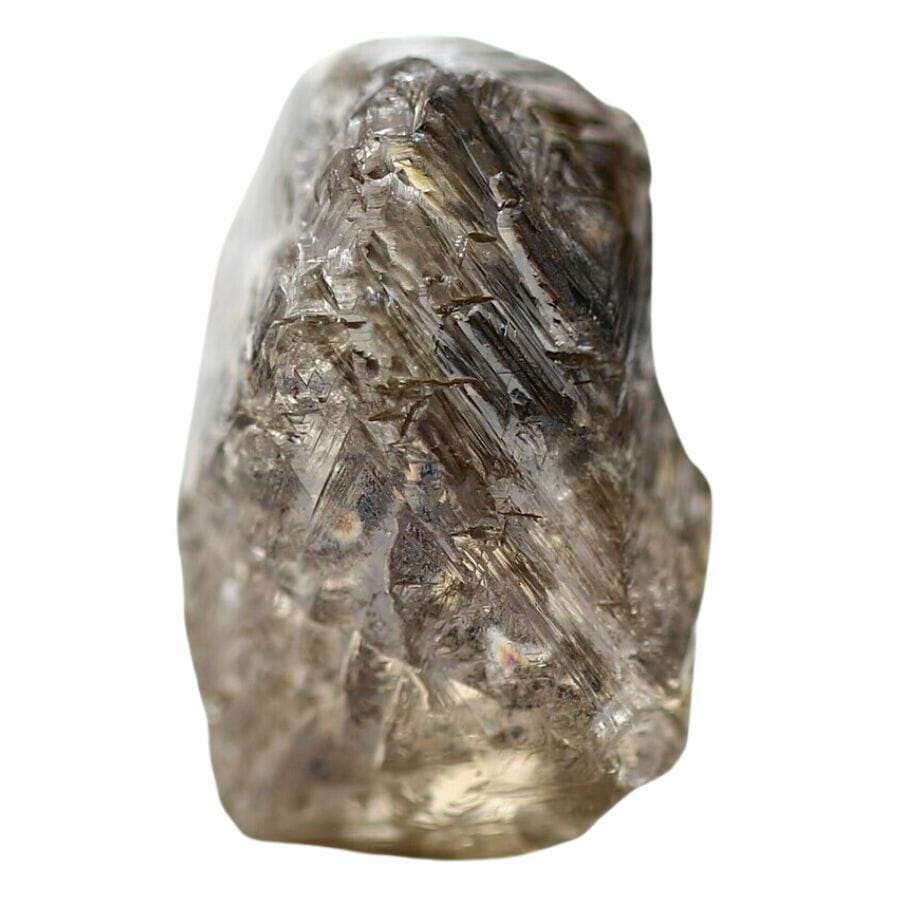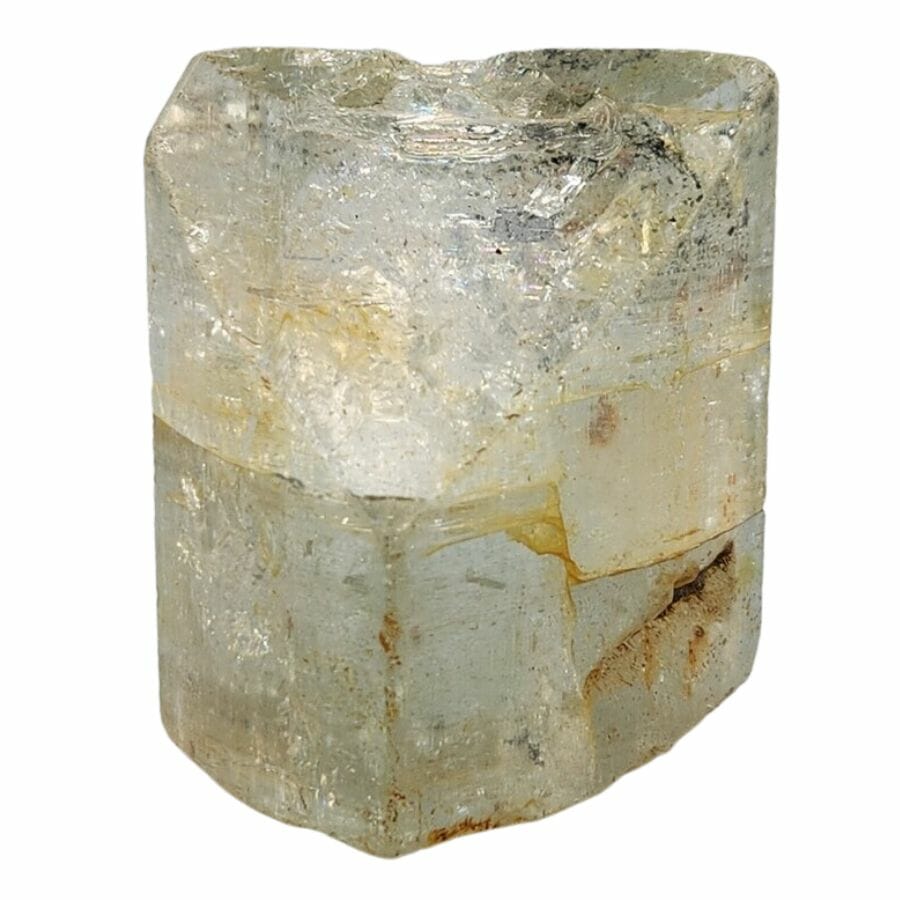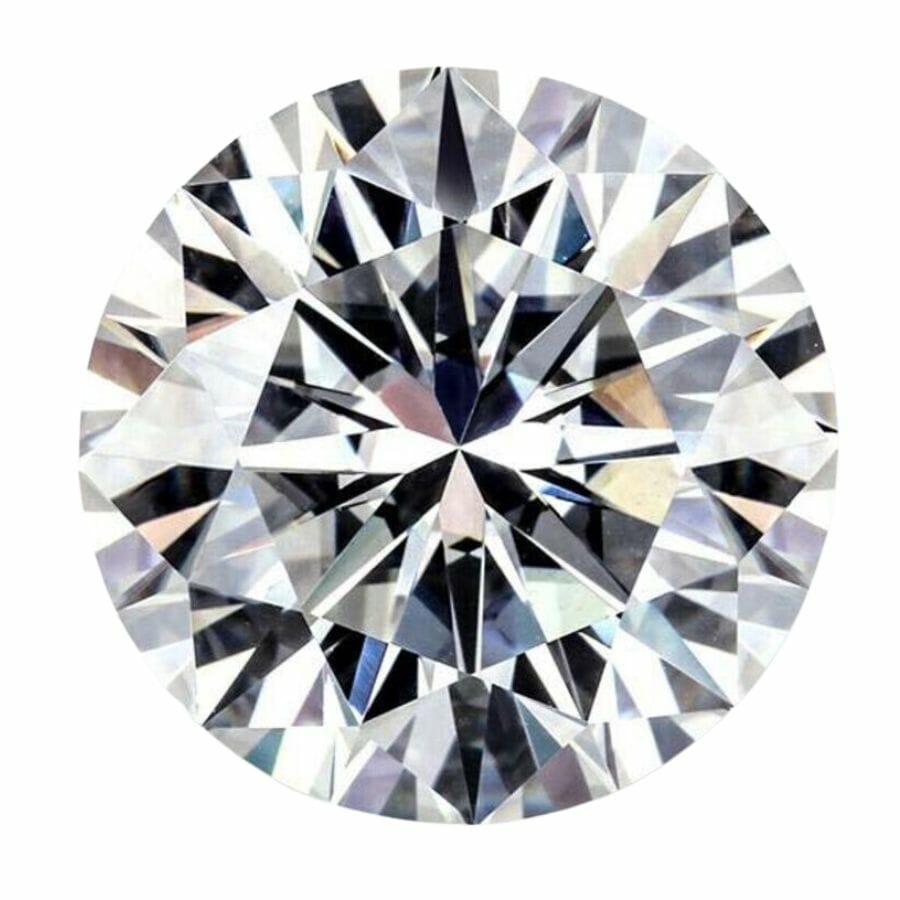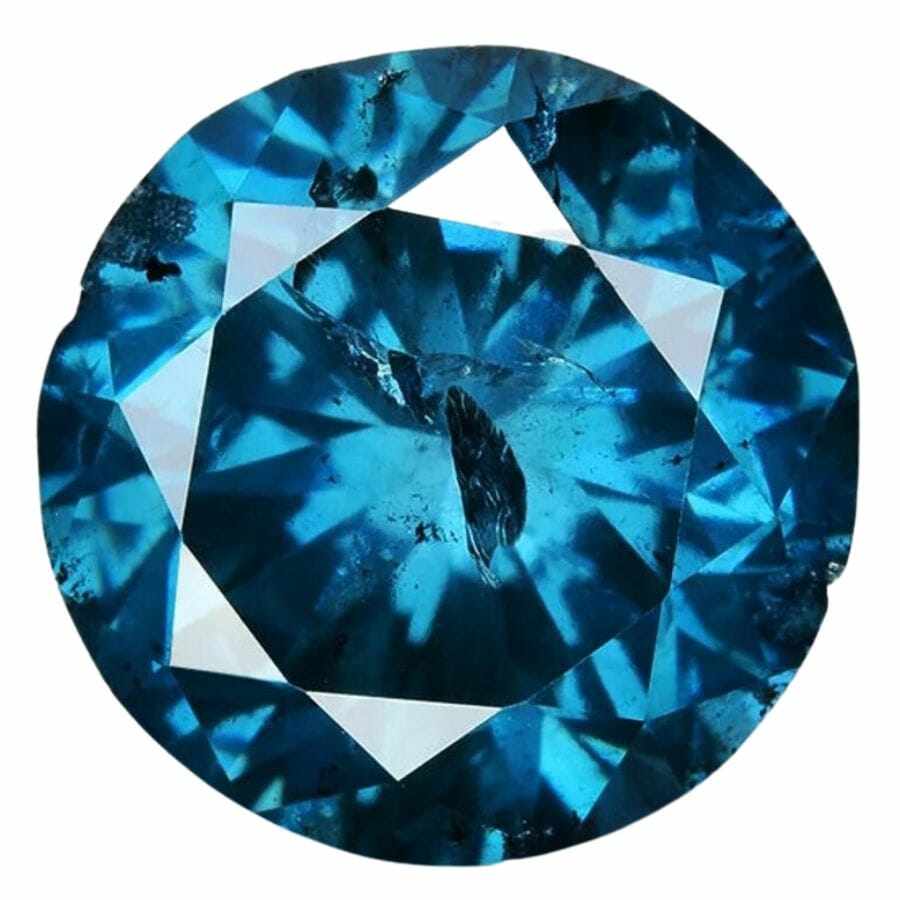White topaz and diamond are two stunning gemstones that often capture our attention. At first glance, they might seem quite similar, both offering a beautiful sparkle and clarity.
However, when you take a closer look and compare white topaz vs diamond, you’ll discover that there are many unique qualities to each stone.
From the way they form deep within the Earth to the ways they interact with light, these gems each have their own story to tell.
We’ll dive into the distinct characteristics that set white topaz and diamond apart, as well as the features they share.
White Topaz vs Diamond – The Major Differences
While white topaz and diamond might look similar to some people, there are actually quite a few differences between them. From how they’re formed to their physical properties, each stone has unique characteristics.
Colors – White topaz is usually white or clear, sometimes with a yellow tint

White topaz is usually clear, and sometimes it can have a pale yellow tint. This happens because of tiny amounts of elements or flaws inside the stone that can affect its color.
On the other hand, diamonds aren’t just clear and colorless. They can be found in a variety of colors like blue, yellow, and pink. The different colors in diamonds are due to the presence of other elements.
For example, a blue diamond has traces of boron, while a yellow diamond contains small amounts of nitrogen.
All gemstones, including white topaz and diamond, get their colors from a combination of factors. These include the minerals present during their formation and any changes they go through over time.
Luster – Diamond has a brilliant shine

Luster is a term used to describe the way light interacts with the surface of a gemstone. It’s basically how shiny a gem appears. Luster can play a big role if you want to tell diamond vs white topaz.
White topaz has a vitreous luster, which means it looks kind of like glass. It’s shiny but in a more subdued way.
On the other hand, diamonds are known for their incredible brilliance. They have what’s called an adamantine luster. This type of luster is the highest level of shine a gem can have, and it’s why diamonds sparkle so much.
When light enters a diamond, it gets bent and reflected in all directions, giving diamonds their famous fire and sparkle.
In comparison, white topaz has a softer, less intense sparkle. Even though both diamonds and white topaz can be clear and look somewhat similar, the way they shine is different. This difference in luster is one of the key ways to tell them apart.
Hardness – White topaz is softer

The Mohs hardness scale is a tool that helps people figure out how hard different minerals are. It goes from 1 to 10, with 1 being super soft (like talc, the stuff in baby powder) and 10 being super hard.
This scale helps people like jewelers or geologists know how easily a gem might get scratched.
Now, when we look at white topaz and diamond, there’s a significant difference in hardness. White topaz sits at 8 on the Mohs scale. That’s pretty hard, but not the hardest. It means that there are a few things that can scratch it if you’re not careful.
Diamonds, on the other hand, are at the very top of the scale. They’re a solid 10. This means they’re the hardest known natural material on Earth. Nothing can scratch a diamond except another diamond.
That’s part of why diamonds are so prized and why they can be used in tools for cutting other hard materials. So, when you compare the two, diamonds are definitely tougher and more resistant to scratches than white topaz.
Crystal structure – Diamond crystals can be shaped like cubes

A gem’s crystal structure is like the blueprint of how its atoms fit together. Think of it like building blocks. The way they are stacked and connected makes each mineral special.
White topaz has what’s called an orthorhombic crystal system. This means the building blocks fit together in a way that forms a boxy shape, but each side of the box is a different length.
The angles between the sides are 90 degrees, but it doesn’t form a perfect cube.
Diamonds, though, are a bit different. They have an isometric or cubic crystal system. This means that all the sides of the cube are equal in length.
When you look at a diamond, the atoms inside are stacked in a way that forms perfect cubes, making the insides look symmetrical and even.
Cleavage – White topaz breaks cleanly in one direction

Cleavage is the ability of a mineral to break along smooth, flat surfaces. Some minerals have an easier time breaking in certain directions because of how their atoms are arranged.
White topaz, for example, has perfect cleavage in one direction. This means if you were to try and split a white topaz, it would break smoothly and evenly in that one particular direction. It’s like having a guide on where to split it.
Diamonds, on the other hand, show off a bit more. They have perfect cleavage in four different directions. That means they can split smoothly in not just one, but four different ways.
Chemical composition – Diamond is only made of carbon

When we talk about the chemical composition of a gemstone, we’re really talking about which elements come together to make up that stone.
White topaz is made up of aluminum silicate and fluorine. This means that it’s a combination of various elements that give white topaz its unique properties and look.
Diamonds, on the other hand, keep things simple. They are made entirely of carbon. Just one element! Even though it’s only one ingredient, the way those carbon atoms bond together makes diamonds super strong and gives them their famous sparkle.
Formation – White topaz forms when melted rock cools down

White topaz and diamonds come to us from very different places inside the Earth.
White topaz crystals form when hot, melted rock starts to cool down. This happens in certain rocks like granite or rhyolite. These rocks have small pockets or fractures where white topaz likes to grow.
So, if you ever decide to go rockhounding near you and you come across these types of rocks, there might be a chance to find white topaz!
Diamonds, on the other hand, have a much more dramatic story. They begin as carbon deep, deep below the Earth’s surface. Here, it’s super hot and there’s a lot of pressure.
These conditions squeeze the carbon atoms together, turning them into diamonds.
This process takes a really long time, maybe even billions of years!
Later, things like volcanic eruptions can bring these diamonds closer to the surface for us to find.
Fluorescence – Diamonds can glow blue under UV light

Fluorescence is a cool thing that some gemstones can do. When you shine ultraviolet (UV) light on them, like from a black light, they can glow in different colors.
This isn’t something you’d see in regular daylight, but under UV light, it becomes noticeable.
Now, when we compare white topaz vs diamond in terms of fluorescence, there are differences.
White topaz can sometimes glow a golden yellow color when you put it under short-wave UV light, and it might look cream-colored under long-wave UV light.
On the other hand, most diamonds will glow blue when they are put under the same kind of light.
So, by checking out this glow, or fluorescence, you can get another hint about whether you’re looking at a white topaz or a diamond.
Conductivity – White topaz does not conduct energy

Conductivity is about how well something can move or transfer energy, especially heat or electricity. Think of it like a race track: some tracks let cars zoom really fast, while others might have lots of roadblocks slowing things down.
White topaz is like a road with lots of roadblocks. It doesn’t let energy, especially heat, pass through it very well. So, it’s known as a poor conductor.
On the other hand, diamonds are pretty amazing in this department. They can let heat zoom through them, making them good conductors of heat. If you ever touch a diamond, it might feel cool because it pulls heat away from your skin so quickly.
Price – Diamond is more expensive

When we talk about gemstones, the price can be a big topic! A lot goes into figuring out how much a gemstone costs. Things like how rare the stone is, its quality, where it comes from, and how hard it is to get all play a part in its price tag.
White topaz is more common and easier to find, so its price is generally lower. If you ever wonder what white topaz is worth, just think about it being like a popular toy that many stores have. Because it’s available in many places, it doesn’t cost a lot.
On the other hand, diamonds are like those super special toys that are hard to find. They’re rarer, especially the really clear and sparkly ones. So, diamonds usually have a higher price.
Location – White topaz is typically found in Brazil

White topaz and diamonds are both beautiful, but they come from different parts of the world. If you’re thinking about mining for crystals, it’s helpful to know where you might find them.
White topaz has several homes across the globe. You can find it in places like Brazil, which is known for having lots of topaz. Other countries where white topaz is found include Sri Lanka, Russia, Pakistan, and Madagascar.
In the United States, topaz has been found in states like Colorado and California.
On the other hand, diamonds have their own favorite spots on the map. Big players in the diamond business include Russia and Botswana. But diamonds don’t just stop there. Canada and Australia have their share of diamonds too.
Also, if you travel to Africa, countries like Congo, South Africa, and Namibia are known for their diamond mines. There are also some spots in the United States where you can find diamonds, like the Crater of Diamonds State Park.
Diamond vs White Topaz – The Similarities
While white topaz and diamond have many differences, they also share some interesting similarities. These shared traits might surprise some people, especially if they only know these gems by their looks.
Clarity – White topaz and diamond are both usually clear

Clarity is a term used to describe how clear a gemstone is. The tiny natural marks or imperfections inside or on the surface of a gem are called inclusions.
Both white topaz and diamonds can have very high clarity. This means they can look super clear to our eyes, almost like clear glass.
But just like other gemstones, both white topaz and diamonds can sometimes have inclusions. Some might be so small that you’d need a magnifying glass to see them. Others might be bigger and can be seen without any special tools.
For jewelry, most people prefer stones that are “eye-clean.” That means even if the gem has tiny inclusions, you can’t see them without magnification.
Streak – Neither gem has a colorless streak

In geology, streak is the color of the powder a mineral leaves behind when it’s scratched against a special plate, usually made of porcelain. Think of it like drawing with a crayon on paper, but instead, you’re using a gemstone on a streak plate!
Because white topaz and diamonds are both super hard gemstones, they usually don’t leave any color behind. In fact, they might even scratch the plate!
So, if you were to try and see the streak of a white topaz or a diamond, you’d probably see no color at all.
Density – The two stones have similar densities

Imagine you have a toy box and you fill it with feathers. It would be super light, right? Now, fill the same box with rocks. It would be much heavier!
That’s because rocks have a higher density than feathers. In the world of gemstones, density tells us how much a certain volume of a gem weighs.
White topaz and diamonds are pretty close when we talk about density. White topaz usually weighs around 3.49 to 3.57 grams per cubic centimeter.
Diamonds are right in the same ballpark, with a density of about 3.52 grams per cubic centimeter.
Magnetism – Both gems exhibit no magnetism

Think about when you put a fridge magnet close to the refrigerator door, and it sticks. Some gemstones can be attracted to magnets because of the minerals in them. But not all gemstones have this magnetic pull.
White topaz and diamonds are two gemstones that don’t play this magnetic game. Both white topaz and diamonds are non-magnetic, which means they won’t be attracted to a magnet no matter how strong it is.
The Easiest Ways to Tell White Topaz and Diamond Apart
Knowing how to tell the difference between white topaz and diamond is handy, especially if you’re thinking of buying one. There are a few methods that you can use to figure out which is which.
Check how the stone shines

Diamonds are known for their amazing sparkle. The way they break light into colorful flashes is called “fire,” and diamonds have lots of it! When you move a diamond under light, it seems to dance with all the colors of the rainbow.
This intense sparkle and fire make diamonds very eye-catching.
White topaz, however, has a different kind of shine. While it’s a beautiful gem, its shine is less flashy. It has a vitreous luster, which means it shines more like glass.
So, if you’re comparing the two, diamonds will have a brighter and more colorful sparkle, while white topaz will give off a more subdued and glassy shine.
Knowing these differences in brilliance can really help if you ever want to figure out if you’re looking at a diamond or a white topaz.
Look for signs of wear

Diamonds have a big reputation for being incredibly hard. In fact, on the hardness scale where minerals are rated, diamonds score a perfect 10. This means that they can scratch almost any other material, but hardly anything can scratch them.
So, when you’re looking at a gemstone and it doesn’t have any scratches on it even after some wear, there’s a good chance it could be a diamond.
On the other side, white topaz doesn’t have that same level of toughness. While it’s still pretty hard, it doesn’t come close to a diamond. White topaz can get scratches, especially if it bumps into harder objects.
If you’re examining a stone and notice some scratches on its surface, that’s a hint that it might be a white topaz and not a diamond.
Breathe on the stone

Diamonds have a unique ability to spread heat fast. This means that they can warm up quickly and don’t hold onto the cold for very long.
One common test to see if a gem is a real diamond is the diamond fog test. When you breathe on a diamond, just like when you breathe on a window, it fogs up.
But because diamonds are so good at spreading heat, that fog won’t last. It goes away almost immediately.
On the flip side, white topaz doesn’t have the same heat-spreading property. When you breathe on white topaz, the foggy layer that forms will hang around for a bit before it fades.
However, keep in mind that this test isn’t foolproof, and you’ll have to account for factors such as humidity and temperature. This test works best if you have a stone that’s confirmed to be a diamond for comparison.


